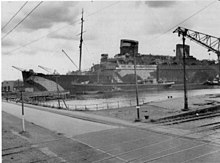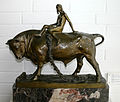Europe (ship, 1930)
|
Four-screw express steamer Europe , 1932
|
||||||||||||||||||
|
||||||||||||||||||
|
||||||||||||||||||
|
||||||||||||||||||
The Europa was a turbine-powered passenger ship operated by North German Lloyd and from 1930 to 1933 it was awarded the Blue Ribbon as the fastest ship on the transatlantic route Europe - New York .
history
Construction phase
The Europe was after the 1929-built sister ship Bremen , from which it differs but significantly differed in a number of details, the second 50,000-ton North German Lloyd. With both ships , the NDL wanted to return to the top class of transatlantic traffic.
The launch at the shipyard of Blohm & Voss (Hamburg) took place on 15 August 1928. In the spring of 1929 should Europe be put into service. In the morning hours of March 26, 1929, a fire broke out at the shipyard's equipment quay and the almost completed ship almost fell victim to it. The fire raged all day and could not be brought under control until the evening. But so much water had run into the ship that it sank to the bottom. The turbine system was badly damaged and the rest of the ship was also badly affected. After long discussions between the shipyard and the shipping company , it was decided to repair the ship. The ship was completed within only eleven months and finally completed its first test drive on February 22, 1930. The cause of the fire could never be fully clarified.
Blue Ribbon
On the maiden voyage from March 19 to March 21, 1930 from Bremerhaven to New York, the Europa temporarily removed the Blue Ribbon from her sister ship Bremen , which she had picked up on July 22, 1929. The Europa reached an average speed of 27.91 knots on the transatlantic route from Europe from Cherbourg to New York in four days, 16 hours and 48 minutes, compared to the Bremen record of 27.83 knots in 1929. On the return journey from New York to Europe According to her record, the Bremen had the same average speed of 27.91 knots as the Europa 1930. In 1933 the Bremen was faster than the Europa at 28.51 knots and was able to regain the Blue Ribbon. In 1932 the German and Austrian Olympic squad chose Europa on the way to host the Games in Los Angeles , one reason is said to have been the high speed of the ship.
Appearance
Like the sister ship Bremen , the Europa also had a catapult with a floatplane on the upper deck between the two funnels , here of the Heinkel HE 58 type , which was then replaced by a Junkers Ju 46 from 1932 to 1935 . The plane was used for faster mail delivery; it was usually taken off board 800 to 1,000 km from the destination port and, coming from America, landed for a while at the water airport in Blexen , but then had usually already flown to another airport in Europe (Southampton, Amsterdam). The pilots and technicians also gained experience that was later used to equip German warships with aircraft. The pilots deployed by Lufthansa were later all among the most experienced long-haul pilots in the company, some with a considerable number of transatlantic flights.
The catapult device was removed at the end of the 1935 season because it was too expensive and complex. On the Europa - as on the Bremen - the chimneys, which were kept flat mainly for reasons of harmonious appearance, were raised after a few years in order to improve smoke extraction.
Second World War
During the Second World War , German marines lived on the luxury steamer from 1939. In 1940 the Europa was hit by a British bomb and the commander Georg Enoch Freiherr von und zu Guttenberg was wounded. He died a short time later. In 1940 the Europa and its sister ship Bremen were converted for use as a troop transport for the Seelöwe company , the planned landing in England. Plans from 1942 to convert the express steamer into an aircraft carrier were not implemented. From February 1945 the ship became the barracks ship of the Wesermünde site administration . In March 1945, the Europa was used as a refugee ship from Swinoujscie to Kiel, where she dropped some of the refugees in the Lübeck Bay. The Europa survived the war almost unscathed. She was seized by the United States and used as a troop transport USS Europa (AP 177). The Europa was later awarded to France as a reparation payment and taken over in May 1946.
Liberté
The ship was rebuilt in France. During this time it broke loose in a storm, collided with the wreck of the Paris and was aground due to flooding. It was lifted in April 1947 and the remodeling was completed. In 1950 the name was changed to Liberté . The chimneys were raised again in 1954, which significantly changed the proportions of the ship. Until 1961, the former Europe drove for the French shipping company CGT from Le Havre to New York.
In 1961 the ship was decommissioned and from January 1962 it was scrapped in La Spezia .
Regular scheduled services
- Bremerhaven - New York (as Europe )
- Le Havre - New York (from 1950 as Liberté )
Passenger capacity
| 1930 (as "Europe") | 1950 (as "Liberté") | ||
| Type of cabin | Number of passengers | Type of cabin | Number of passengers |
|---|---|---|---|
| 1st Class | 687 | 1st Class | 549 |
| 2nd Class | 524 | Cabin class | 562 |
| Tourist class | 306 | Tourist class | 382 |
| 3rd grade | 507 | ||
Picture gallery
March 1930 - The Europa (front of the pier) together with her sister ship Bremen (rear) in Bremerhaven
Depiction of the steamship Europa in Meyers Blitz-Lexikon , Leipzig 1932, digital full-text edition
Europa on the bull (bronze sculpture by Lilli Finzelberg in the German Maritime Museum ), gift from American citizens to Commodore Johnsen on his first arrival in New York with the Europa
See also
literature
- Robert D. Ballard / Ken Marschall : Lost Liners - From the Titanic to Andrea Doria - the glory and the sinking of the great luxury liners . Wilhelm Heyne Verlag GmbH & Co., Munich 1997, ISBN 3-453-12905-9 (English: Lost Liners: From the Titanic to the Andrea Doria. The ocean floor reveals its greatest lost ships. Translated by Helmut Gerstberger).
Web links
Individual evidence
- ^ Elisabeth zu Guttenberg: Called by Name - Memories. Ullstein Verlag, Berlin 1993, ISBN 3-548-23260-4 , page 149f.












